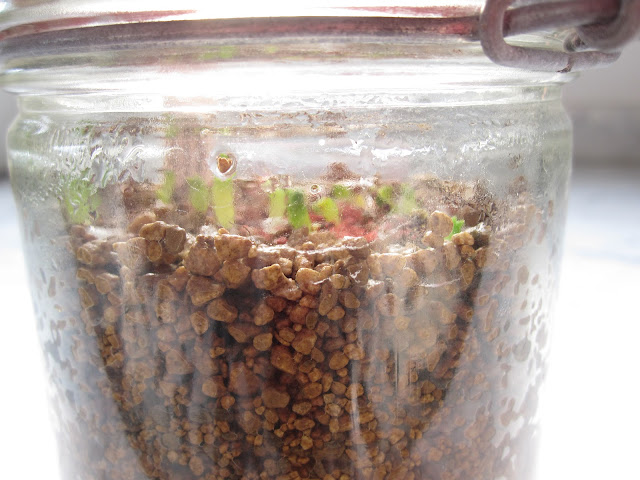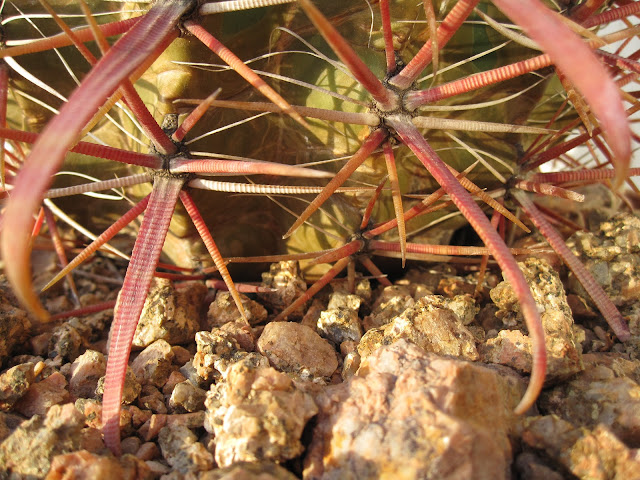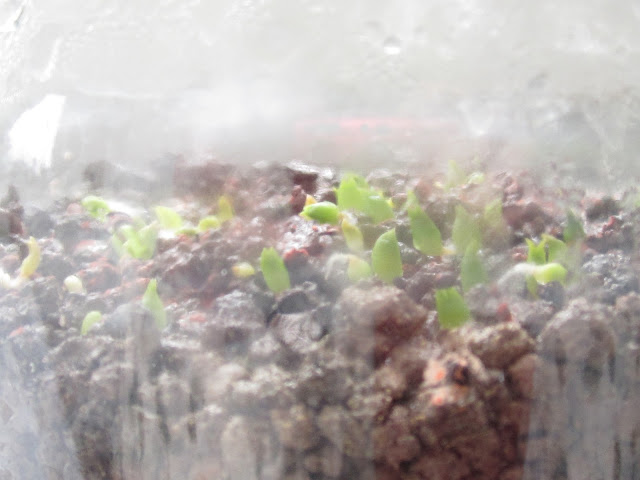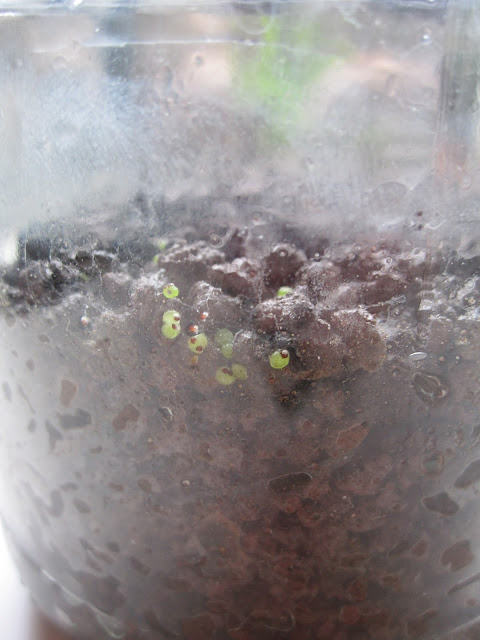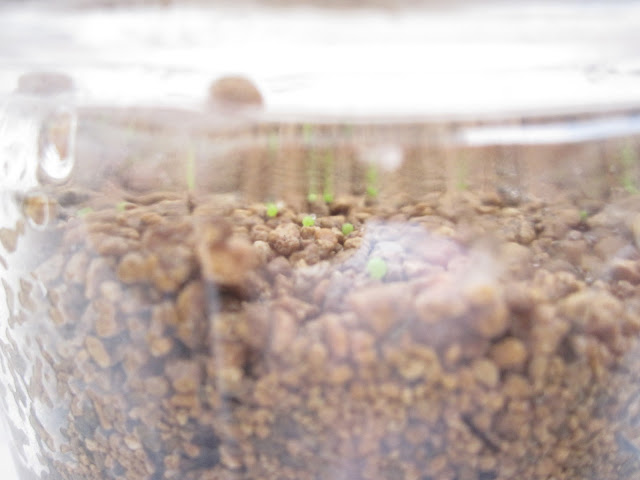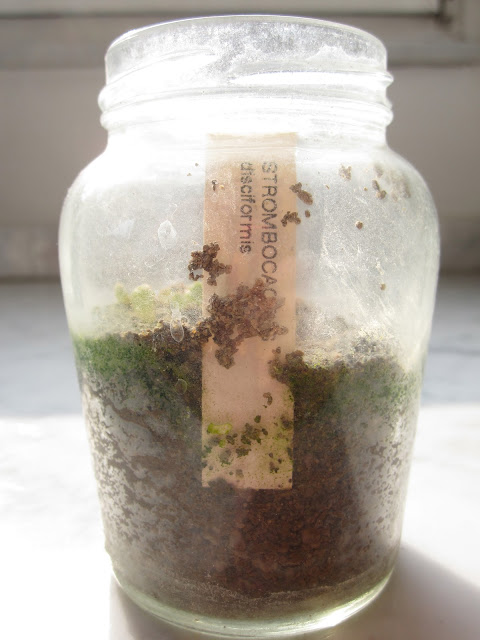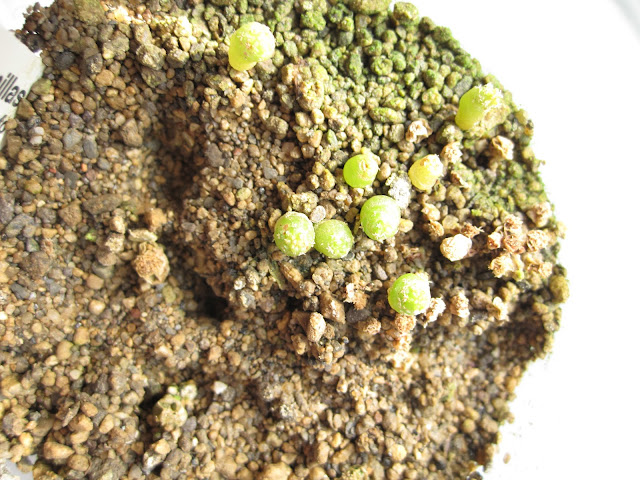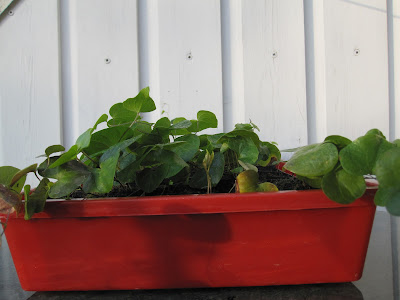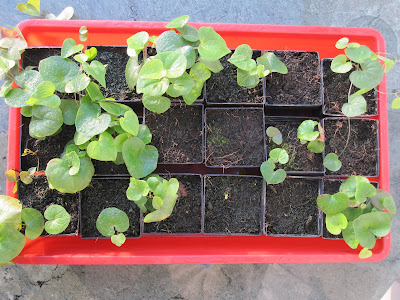Also sown in March 2013 is FEROCACTUS JOHNSTONIANUS.
This time i used pumice as substrate.
The first seedlings appeared after 12 days and the seeds are germinating more slowly than the other FEROCACTUS.
31 March 2013
FEROCACTUS GRACILIS
Only if you have seen FEROCACTUS GRACILIS in its natural habitat you will know its full beauty.
The name "gracilis" is latin and means "tender" or "slim" and refers to the slender columns FEROCACTUS GRACILIS builds up.
This Ferocactus grows in the middle part of BAJA CALIFORNIA from the SIERRA SAN MIGUEL and SIERRA SAN PIEDRO MÁRTIR down to the south near the village JARAGUAY at CATAVIUA and PUNTA PRIETA.
They grow near the coast in sandy plains up to the mountains in 1300 m on rocky soil.
They grow together with IDRIA COLUMNARIS and thus have a similar resistance against drought and high temperature.
I cultivate it like other Ferocacti but water it less often as them. I have planted my FEROCACTUS GRACILIS in pure GRANITE so that the water may run off very quickly.
The name "gracilis" is latin and means "tender" or "slim" and refers to the slender columns FEROCACTUS GRACILIS builds up.
This Ferocactus grows in the middle part of BAJA CALIFORNIA from the SIERRA SAN MIGUEL and SIERRA SAN PIEDRO MÁRTIR down to the south near the village JARAGUAY at CATAVIUA and PUNTA PRIETA.
They grow near the coast in sandy plains up to the mountains in 1300 m on rocky soil.
They grow together with IDRIA COLUMNARIS and thus have a similar resistance against drought and high temperature.
I cultivate it like other Ferocacti but water it less often as them. I have planted my FEROCACTUS GRACILIS in pure GRANITE so that the water may run off very quickly.
literature
g. unger DIE GROSSEN KUGELKAKTEEN NORDAMERIKAS
www.cactus-art.biz
www.cactuspro.com
www.theferocactus.free.fr
SOWING FEROCACTUS EMORYI 2013
FEROCACTUS EMORYI is known by others as FEROCACTUS COVILLEI. But EMORYI is the correct name used at first by ENGELMANN in 1857 or possibly in 1856. COVILLEI as used by BRITTON & ROSE later on should be used as a synonym.
I have sown these seeds in March 2013 too. As you may see i took lava as a substrate again and the seedlings are growing fast in their first days. The seeds germinated after 10 days and keep on germinating.
I have sown these seeds in March 2013 too. As you may see i took lava as a substrate again and the seedlings are growing fast in their first days. The seeds germinated after 10 days and keep on germinating.
SOWING FEROCACTUS DIGUETII 2013
I have sown these seeds in March 2013. The first ones germinated after 5 days and keep going on germinating.
As you may see they grow really fast in their first days. As substrate i used lava.
As you may see they grow really fast in their first days. As substrate i used lava.
FEROCACTUS CHRYSACANTHUS
This is the most beautiful of all Ferocactus species...
It is named for its golden thorns. In antique greek "chrysos" means "amber coloured" or "golden" and "akantos" means "thorned" or "spiny".
FEROCACTUS CHRYSACANTHUS is woven in a nest of yellow golden thorns. Some plants have greyish coloured "spines" others have red brown ones.
FEROCACTUS CHRYSACANTHUS "lives" on the islands of CEDROS and SAN BENITO near the western coast of BAJA CALIFORNIA in the PACIFIC OCEAN.
May be it grows on the continental part of BAJA CALIFORNIA too but no place as such has been found until today.
The height may be up to 1 m and its breadth may reach 0,3 m. The plants grow near the coast at coastal level up to the slopes and the hills.
The culture is not difficult.
Growing season begins in April or May. The cactus needs all the sun and warmth you can spare. When the temperature during the nights does not undergo 15 °C i put them out on the balcony. In the first weeks i spray it in the morning and evening with water. Watering begins when the apex and thorns show growth.
I water it during the whole summer and autumn until the winter has come. Some growers make a short resting time in July or August. You need to have expertise to recognize when the time has come to do this.
When the night temperature drops under 15 °C i bring my cactus inside the house. But give the cactus as long as possible sun and low temperatures in the nights to stop its growth and harden the plant.
In winter i keep it absolutely dry and the temperature never drops under 15 °C.
It is named for its golden thorns. In antique greek "chrysos" means "amber coloured" or "golden" and "akantos" means "thorned" or "spiny".
FEROCACTUS CHRYSACANTHUS is woven in a nest of yellow golden thorns. Some plants have greyish coloured "spines" others have red brown ones.
FEROCACTUS CHRYSACANTHUS "lives" on the islands of CEDROS and SAN BENITO near the western coast of BAJA CALIFORNIA in the PACIFIC OCEAN.
May be it grows on the continental part of BAJA CALIFORNIA too but no place as such has been found until today.
The height may be up to 1 m and its breadth may reach 0,3 m. The plants grow near the coast at coastal level up to the slopes and the hills.
The culture is not difficult.
Growing season begins in April or May. The cactus needs all the sun and warmth you can spare. When the temperature during the nights does not undergo 15 °C i put them out on the balcony. In the first weeks i spray it in the morning and evening with water. Watering begins when the apex and thorns show growth.
I water it during the whole summer and autumn until the winter has come. Some growers make a short resting time in July or August. You need to have expertise to recognize when the time has come to do this.
When the night temperature drops under 15 °C i bring my cactus inside the house. But give the cactus as long as possible sun and low temperatures in the nights to stop its growth and harden the plant.
In winter i keep it absolutely dry and the temperature never drops under 15 °C.
literature
g. unger DIE GROSSEN KUGELKAKTEEN NORDAMERIKAS
www.cactus-art.biz
www.cactuspro.com
www.theferocactus.free.fr
SOWING STROMBOCACTUS DISCIFORMIS 2011
STROMBOCACTUS DISCIFORMIS sown in January 2011 under the FLEISCHER METHOD.
This time i used lava as a substrate instead of pumice.
ALLUAUDIA MONTAGNACII
ALLUAUDIA MONTAGNACII has been collected by M.R. MONTAGNAC, a french collector, who brought this beautiful species in the our collections. W. RAUH described the species in 1961.
The species has a very confined area where it grows. This is near ITAMPOLO, on the south western coast of MADAGASCAR.
ALLUAUDIA PROCERA is growing in the same habitats too.
ALLUAUDIA ASCENDENS has a very similar look. But ALLUAUDIA MONTAGNACII has the growing habit of ALLUAUDIA ASCENDENS and the flowers or inflorescence from ALLUAUDIA PROCERA. Therefore it could be a natural hybrid what has not been proven to this very day.
For me it looks more beautiful and more elegant than ALLUAUDIA ASCENDENS. Its leaflets are smaller and darker green. And the thorns look stronger and longer than those from ALLUAUDIA ASCENDENS. But it could be that my plants are only a variation and are not typical.
My plants are cuttings. When i took them i swallowed the cutting end in charcoal powder and afterwards powdered it carefully with AUXIN or GIBERELLIN ACID. This is a phytohormone or plant hormone or more precise a growing hormone. Scientists and commercial growers use it in plant cell cultures or propagation cultures. This hormone really facilitates the building of new roots. About 4 weeks the cuttings stayed on dry pumice in a warm and shaded place. Then i potted them in my containers with my normal substrate mixture, offered them a warm half shaded half sunny place and sprayed them with warm water as often as i had the time to do so. Of course summer is the best time to do so.
Culture of ALLUAUDIA and all other DIDIEREACEAE is very very easy.
I use my normal substrate.
Water them like you do your cacti. Watering begins when the DIDIEREACEAE show their first leaflets. When they emerge you might not see them for they are very light green coloured and so tiny. Fertilizer is allways added to my water but in very very small amounts.
The growing season begins in April or May. I put my plants out on the balcony when nights temperature might not fall under 15°C. The whole spring, summer and autumn they will stand in full sun. Shade is not a good offer.
When the nights temperature goes under 15°C or maximal 10°C i put the plants inside the house. Normally their leaflets are dark green and the plants are still growing. So watering keeps on going.
When their leaflets are yellowing you will know that the summer is over and no more water will be offered. The temperature in winter should not be under 10°C, maybe 15°C would be better.
As you may have acknowledged the begin of winter and its end cannot be tied upon a months name. As with many succulents the sprouting of their leaflets and leaves tell you when to begin watering and when to end it.
For me it is very easy. I cultivate the DIDIEREACEAE like DISCOCACTUS, MELOCACTUS, MYRTILLOCACTUS, PACHYCEREUS and UEBELMANNIA.
The species has a very confined area where it grows. This is near ITAMPOLO, on the south western coast of MADAGASCAR.
ALLUAUDIA PROCERA is growing in the same habitats too.
ALLUAUDIA ASCENDENS has a very similar look. But ALLUAUDIA MONTAGNACII has the growing habit of ALLUAUDIA ASCENDENS and the flowers or inflorescence from ALLUAUDIA PROCERA. Therefore it could be a natural hybrid what has not been proven to this very day.
For me it looks more beautiful and more elegant than ALLUAUDIA ASCENDENS. Its leaflets are smaller and darker green. And the thorns look stronger and longer than those from ALLUAUDIA ASCENDENS. But it could be that my plants are only a variation and are not typical.
My plants are cuttings. When i took them i swallowed the cutting end in charcoal powder and afterwards powdered it carefully with AUXIN or GIBERELLIN ACID. This is a phytohormone or plant hormone or more precise a growing hormone. Scientists and commercial growers use it in plant cell cultures or propagation cultures. This hormone really facilitates the building of new roots. About 4 weeks the cuttings stayed on dry pumice in a warm and shaded place. Then i potted them in my containers with my normal substrate mixture, offered them a warm half shaded half sunny place and sprayed them with warm water as often as i had the time to do so. Of course summer is the best time to do so.
Culture of ALLUAUDIA and all other DIDIEREACEAE is very very easy.
I use my normal substrate.
Water them like you do your cacti. Watering begins when the DIDIEREACEAE show their first leaflets. When they emerge you might not see them for they are very light green coloured and so tiny. Fertilizer is allways added to my water but in very very small amounts.
The growing season begins in April or May. I put my plants out on the balcony when nights temperature might not fall under 15°C. The whole spring, summer and autumn they will stand in full sun. Shade is not a good offer.
When the nights temperature goes under 15°C or maximal 10°C i put the plants inside the house. Normally their leaflets are dark green and the plants are still growing. So watering keeps on going.
When their leaflets are yellowing you will know that the summer is over and no more water will be offered. The temperature in winter should not be under 10°C, maybe 15°C would be better.
As you may have acknowledged the begin of winter and its end cannot be tied upon a months name. As with many succulents the sprouting of their leaflets and leaves tell you when to begin watering and when to end it.
For me it is very easy. I cultivate the DIDIEREACEAE like DISCOCACTUS, MELOCACTUS, MYRTILLOCACTUS, PACHYCEREUS and UEBELMANNIA.
literature
g.d. rowley DIDIEREACEAE "CACTI OF THE OLD WORLD" bcss 1992
www.bihrmann.com
SOWING STROMBOCACTUS PULCHERRIMUS 2013
This is STROMBOCACTUS PULCHERRIMUS that i have sown in march 2013.
After 1 week the first seedlings emerged out of their seed capsules. They keep on doing it and this may last until the next 2 or 3 weeks.
The glass stands on an eastern window with the warmth coming beneath from a radiator. The glass will not be opened in the first year. The procedure has been described in the FLEISCHER METHOD.
After 1 week the first seedlings emerged out of their seed capsules. They keep on doing it and this may last until the next 2 or 3 weeks.
The glass stands on an eastern window with the warmth coming beneath from a radiator. The glass will not be opened in the first year. The procedure has been described in the FLEISCHER METHOD.
SOWING STROMBOCACTUS DISCIFORMIS 2012
These seeds have been sown in March 2012.
Today in March 2013 they nearly have the size of an ant.
Their culture is very easy. A half shaded half sunny place, warmth from beneath and every day a short spraying with water and a little bit fertilizer.
Today in March 2013 they nearly have the size of an ant.
Their culture is very easy. A half shaded half sunny place, warmth from beneath and every day a short spraying with water and a little bit fertilizer.
30 March 2013
ECHINOCACTUS POLYCEPHALUS regrafting 2013
This is ECHINOCACTUS POLYCEPHALUS grafted upon FEROCACTUS POTTSII. "They" are about 5 years old. Its look does not please me very much so that i will regraft it on a new F. POTTSII.
ORTEGOCACTUS MACDOUGALLII regrafting 2013
ORTEGOCACTUS MACDOUGALLII is the only species in the genus. T. MACDOUGALL found it in the SAN JOSÉ DE LACHIGUIRI MASSIV in OAXACA, MEXICO, after whom the species was named in 1961 by ALEXANDER.
The cactus grows on mountains from 2500 m up to 2700 m between lichens and mosses. There it grows on basalt, a vulcanic rock, barely shaded and fully exposed to the sun the whole day long.
As the lichens and mosses indicate there has to be a good plenty of fog and rain. But the basalt will not hold the water for a longer time.
Temperature cannot be very high because of the "alpine habitat", but the intensity of the sun forms the special character of this cactus.
ORTEGOCACTUS MACDOUGALLII has a light green body but you might not see it. The corp is covered with wax and that gives the cactus that beautiful white blueish colour.
BOWIEA VOLUBILIS
BOWIEA VOLUBILIS or BOWIEA VOLUBILIS SSP. VOLUBILIS - this depends of the correct systematical status you might accept - is known by gardeners as "climbing onion", "sea onion" or "zulu potato".
BOWIEA KILIMANDSCHARICA, near the mount KILIMANDSCHARO, and BOWIEA NANA, with smaller bulbs, are thought to be synonyms.
The name BOWIEA is given after a british plant collector, named JAMES BOWIE, living from 1789 to 1869, in england. The genus has been created in 1867 by WILLIAM HENRY HARVEY.
The habitats of BOWIEA VOLUBILIS are river valleys, bush savanna and hills and slopes. You will find "her" from East Africa down to the eastern South Africa.
If you accept BOWIEA GARIEPENSIS as a synonym than BOWIEA VOLUBILIS will extend its habitats over the southern and south western parts of South Africa up to southern Namibia.
The bulbs are geophytes that means they are buried down in the earth - as mostly all bulbs are - and might reach a diameter of about 25 cm.
The shoots are thriving up to a height of 5 m.
BOWIEA VOLUBILIS will grow in every substrate. It favors granitic and humus soil.
My BOWIEA is a seedling i have sown in 2008. The bulb is as big as a tennis ball and i have buried it deep in the earth in its first year. Nowadays it has outgrown its earthen "prison".
As substrate i use lava and peat as a 50% to 50% mixture.
Watering will begin when the bulb shows its first shoots. This might be in April, May or June. I treat the plant as my normal cacti and water again only when the substrate has been dried out again. Or nearly dried out. This is not a must!
Fertilizer is allways added to the water and thus in a very low concentration. In nature this will be the same.
When the branches and branchlets are yellowing it is time to stop the watering. I put it under a shelter so that the rainfall might not weaten the plant. If the temperature goes under 10°C i will take her inside. During winter she will stand temperatures down to 5°C.
The plant stands the whole spring, summer and autumn out on my balcony. I only shelter it from rain if the bulb stays dormant.
Flowering will occure in the end of summer and the autumn. The flowers are green and no beauties at all.
My plant has never born fruits or seeds. I don t know if you might need 2 plants to have sex and harvest seeds.
It is a very easy to cultivate plant. The whole plant is green - the bulb, the branches and branchlets, the flowers...
BOWIEA KILIMANDSCHARICA, near the mount KILIMANDSCHARO, and BOWIEA NANA, with smaller bulbs, are thought to be synonyms.
The name BOWIEA is given after a british plant collector, named JAMES BOWIE, living from 1789 to 1869, in england. The genus has been created in 1867 by WILLIAM HENRY HARVEY.
The habitats of BOWIEA VOLUBILIS are river valleys, bush savanna and hills and slopes. You will find "her" from East Africa down to the eastern South Africa.
If you accept BOWIEA GARIEPENSIS as a synonym than BOWIEA VOLUBILIS will extend its habitats over the southern and south western parts of South Africa up to southern Namibia.
The bulbs are geophytes that means they are buried down in the earth - as mostly all bulbs are - and might reach a diameter of about 25 cm.
The shoots are thriving up to a height of 5 m.
BOWIEA VOLUBILIS will grow in every substrate. It favors granitic and humus soil.
My BOWIEA is a seedling i have sown in 2008. The bulb is as big as a tennis ball and i have buried it deep in the earth in its first year. Nowadays it has outgrown its earthen "prison".
As substrate i use lava and peat as a 50% to 50% mixture.
Watering will begin when the bulb shows its first shoots. This might be in April, May or June. I treat the plant as my normal cacti and water again only when the substrate has been dried out again. Or nearly dried out. This is not a must!
Fertilizer is allways added to the water and thus in a very low concentration. In nature this will be the same.
When the branches and branchlets are yellowing it is time to stop the watering. I put it under a shelter so that the rainfall might not weaten the plant. If the temperature goes under 10°C i will take her inside. During winter she will stand temperatures down to 5°C.
The plant stands the whole spring, summer and autumn out on my balcony. I only shelter it from rain if the bulb stays dormant.
Flowering will occure in the end of summer and the autumn. The flowers are green and no beauties at all.
My plant has never born fruits or seeds. I don t know if you might need 2 plants to have sex and harvest seeds.
It is a very easy to cultivate plant. The whole plant is green - the bulb, the branches and branchlets, the flowers...
literature
www.bihrmann.com
www.cactuspro.com
www.columbus-cactus-club.webs.com
www.pacificbulbsociety.org
www.plantzafrica.com
www.succulent-plant.com
BOWIEA GARIEPENSIS
BOWIEA GARIEPENSIS or as some taxonomists might tell BOWIEA VOLUBILIS SSP. GARIEPENSIS could be a subspecies of the better known BOWIEA VOLUBILIS or could really be a synonym.
Some botanists say that both subspecies do differ in some anatomical and morphological characteristics - the leaf and the flower - and other deny that at all.
I have seen both plants in botanical gardens but never this subspecies in a private collection. I cannot tell if there is any difference at all.
You might find BOWIEA VOLUBILIS SSP. GARIEPENSIS from southern Namibia to south western South Africa.
It has been discovered near the ORANJE RIVER, the BUR name, english ORANGE RIVER, GARIEP as it is named by the NAMAS, or HOTTENTOTS as they were named by the BURS. This explains the name GARIEPENSIS, from the GARIEP.
Its diameter can be up to 20 cm. The height of its shoots may be as long or high as 3 m. The bulb or bulbs are buried down in the earth. You might only see the growing shoots but vastly the bulb itself.
Growing season will be in May, June and July.
The temperature will be more than 7°C.
Some botanists say that both subspecies do differ in some anatomical and morphological characteristics - the leaf and the flower - and other deny that at all.
I have seen both plants in botanical gardens but never this subspecies in a private collection. I cannot tell if there is any difference at all.
You might find BOWIEA VOLUBILIS SSP. GARIEPENSIS from southern Namibia to south western South Africa.
It has been discovered near the ORANJE RIVER, the BUR name, english ORANGE RIVER, GARIEP as it is named by the NAMAS, or HOTTENTOTS as they were named by the BURS. This explains the name GARIEPENSIS, from the GARIEP.
Its diameter can be up to 20 cm. The height of its shoots may be as long or high as 3 m. The bulb or bulbs are buried down in the earth. You might only see the growing shoots but vastly the bulb itself.
Growing season will be in May, June and July.
The temperature will be more than 7°C.
SCHIZOBASIS INTRICATA
SCHIZOBASIS INTRICATA or as it is now named DRIMIA INTRICATA is a very fragile, tender and small plant.
I fell in love with it when i saw it in the greenhouses of a friend of mine. His plant was in "her" twenties and consisted of 5 bulbs with many dead shouts which builded up a "nest" around "her" body. It surely was a beautiful view.
I pleaded for seeds and started sowing them the very next day.
My plant was born in 2008 and is only one out of the bunch of my seedlings. I cultivate "her" like a bonsai and "her" culture really is very easy.
SCHIZOBASIS consists of only one species. It is a member of the family HYCINTHACEAE, a sister group of the family THEMIDACEAE, and a near relative to the AGAVACEAE.
In 2004 a botanist publicated his work on the HYACINTHACEAE. He rearranged some genera and SCHIZOBASIS will be now DRIMIA.
You may find "her" from Ethiopia along East Africa down to South Africa and South West Africa. I have not found something more detailed information. So i cannot tell you if it is confined only to the coastal parts of these countries or may be found in their central parts too.
The bulbs may grow up to 6 cm in diameter - so some authors say - but i have never seen a bulb bigger than a walnut. All plants i have seen were build up to a handful of bulbs.
The culture...
Treat "her" like your cacti or succulents. "Her" growing season will start when she sends "her" shoots out of the bulb. This will be around February, March or April. The sun and warmth you will give her at this time will be the starting signal. Over the spring and summer i give her the normal mass of fertilizer and water i will offer my other cacti too. My SCHIZOBASIS INTRICATA stands in full sun and has to endure the typical weather here in South Germany.
When "her" shoots start yellowing i cut off the watering. This may be in September, October or November. I put "her" under a shelter and let "her" stand outside as long as possible. Only if the temperature drops under 10 °C i will take "her" inside. During the winter i don t give her any water and the temperature will range from 10 °C up to 15 °C. "She" might stand 5 °C too but i never tried doing this.
The substrate is a mixture of peat and lava as 1 to 1. I only water if the whole substrate is dry.
"She" flowers very early in summer and the fruits are born without some help. The black seeds can be harvested some weeks later on.
Sowing is really annoying. You really have to wait a long time because the growth of the seedlings is very very very slow. But anyway sowing is very easy.
Give SCHIZOBASIS INTRICATA a try. The older "she" grows the lovelier "she" will look.
I fell in love with it when i saw it in the greenhouses of a friend of mine. His plant was in "her" twenties and consisted of 5 bulbs with many dead shouts which builded up a "nest" around "her" body. It surely was a beautiful view.
I pleaded for seeds and started sowing them the very next day.
My plant was born in 2008 and is only one out of the bunch of my seedlings. I cultivate "her" like a bonsai and "her" culture really is very easy.
SCHIZOBASIS consists of only one species. It is a member of the family HYCINTHACEAE, a sister group of the family THEMIDACEAE, and a near relative to the AGAVACEAE.
In 2004 a botanist publicated his work on the HYACINTHACEAE. He rearranged some genera and SCHIZOBASIS will be now DRIMIA.
You may find "her" from Ethiopia along East Africa down to South Africa and South West Africa. I have not found something more detailed information. So i cannot tell you if it is confined only to the coastal parts of these countries or may be found in their central parts too.
The bulbs may grow up to 6 cm in diameter - so some authors say - but i have never seen a bulb bigger than a walnut. All plants i have seen were build up to a handful of bulbs.
The culture...
Treat "her" like your cacti or succulents. "Her" growing season will start when she sends "her" shoots out of the bulb. This will be around February, March or April. The sun and warmth you will give her at this time will be the starting signal. Over the spring and summer i give her the normal mass of fertilizer and water i will offer my other cacti too. My SCHIZOBASIS INTRICATA stands in full sun and has to endure the typical weather here in South Germany.
When "her" shoots start yellowing i cut off the watering. This may be in September, October or November. I put "her" under a shelter and let "her" stand outside as long as possible. Only if the temperature drops under 10 °C i will take "her" inside. During the winter i don t give her any water and the temperature will range from 10 °C up to 15 °C. "She" might stand 5 °C too but i never tried doing this.
The substrate is a mixture of peat and lava as 1 to 1. I only water if the whole substrate is dry.
"She" flowers very early in summer and the fruits are born without some help. The black seeds can be harvested some weeks later on.
Sowing is really annoying. You really have to wait a long time because the growth of the seedlings is very very very slow. But anyway sowing is very easy.
Give SCHIZOBASIS INTRICATA a try. The older "she" grows the lovelier "she" will look.
literature
j. manning & p. goldblatt & m.f. fay, A REVISED GENERIC SYNOPSIS OF HYACINTHACEAE IN SUB SAHARAN AFRICA, edinburgh journal of botany, volume 60 (3):533-568, 2004
www.bihrmann.com
www.dadadoro.blog54.fc2.com
www.j-mama.cocolog-nifty.com
www.pacificbulbsociety.org
www.plantzafrica.com
www.plaza.rakuten.co.jp/gamanma/diary
26 March 2013
IDRIA COLUMNARIS "BOOJUM"
IDRIA COLUMNARIS, the "BOOJUM", or FOUQUIERIA COLUMNARIS, as it is named by other botanists, is a member of the family FOUQUIERIACEAE.
It lives in Central Baja California, a peninsula, on the island Angel De La Guarda, in the Gulf of California, and near the village Libertad, at the coast of Sonora, Mexico.
It occurs from near sea level up to about 1000 m in the mountains. There it is growing with AGAVE SHAWII SSP. GOLDMANIANA, PACHYCEREUS PRINGLEI, a cactus, PACHYCORMUS DISCOLOR, "EL COPALQUIN", a member of the ANACARDIACEAE, YUCCA VALIDA, "EL DATILILLO", and FOUQUIERIA SPLENDENS, "EL OCOTILLO", another member of the FOUQUIERIACEAE. They all grow in forming a bushy savanna or succulent forest.
The "BOOJUM" will grow in sand, chalkstone or limestone, sandstone, basalt or granite. Granite as a substrate will be prefered overall.
IDRIA will grow up to 23 m and reach a thickness of about 1 m at its basis. The age of the oldest plants is said to become some hundreds years. But no exact age has been found until this very day.
The "BOOJUM" may be named "EL CIRION", the candle, by the mexicans too. The name "BOOJUM" is originated by the LEWIS CARROLL classic poem "THE HUNTING OF THE SNARK". For a snark is a creature of fantasy, created by the author, which cannot be described as it is ineffable. The boojum is a variety of a snark.
As the botanist GODFREY SYKES wandered through Baja California and this strange plant came into his sight, he exclaimed "A BOOJUM! DEFINITELY A BOOJUM!" So it is said. And this is how this strange oddity came to its strange name.
The morphology of IDRIA is very simple. It has a central stem from which are sprouting long trunks with egg shaped leaves. These leaves are stalked, and if the leaves are fading away all they will leave behind are their central ribs. These ribs will become the thorns of the stem and trunks.
In the axillae, "the armpit", will emerge the short trunks or side branchlets with unstalked leaves. These leaves will emerge as tufts and they will leave nothing if they die.
In culture you may see many a time the emerging and growing of leaves if there is water and the yellowing and dying of these leaves if there is water not any more. For growing this species this is a very clear and easy to follow advice for your watering regime.
As IDRIA is confined to a very small area on Baja California, about 120 km x 400 km, its climate is very special.
Winter rain occurs from December until February. In March or April until July no rain will fall. The summer rain will fall in August and September. October and November again will see no rain. Foggy mists will occur over the year and will spend some water.
The annual rainfall amount may not exceed 110 mm.
The annual temperature will be around 20 °C.
North of Central Baja California it is to cold to grow for IDRIA, south of Central Baja California it is to dry and hot.
IDRIA germinates and grows in its habitats in the shade of bushes and shrubs. They protect the tender plants from the drying sun. Becoming older and taller they outgrow their sheltering bushes and shrubs and prosper to these marvellous "BOOJUMS".
Cultivating IDRIA is very easy. I do use my normal substrate, normal pots, and water them allways when there will be leaves. Allways i give them the sunniest and warmest place i can offer. I cultivate them together with my FEROCACTUS CHRYSACANTHUS, F. JOHNSTONIANUS, MELOCACTUS, UEBELMANNIA and other warmth loving succulents. Only the watering of IDRIA is different from the other succulents. Keep allways an open eye at the emerging of leaves and their yellowing. This will tell you if and when to water. I fertilize them as i do it with all my succulents. Allways, but a very very very small amount of fertilizer is added at every watering. In nature this is the way it goes.
Last but not least, don t think that your "BOOJUM" will outgrow your fastest expectations. IDRIA is very very very slow growing.
It lives in Central Baja California, a peninsula, on the island Angel De La Guarda, in the Gulf of California, and near the village Libertad, at the coast of Sonora, Mexico.
It occurs from near sea level up to about 1000 m in the mountains. There it is growing with AGAVE SHAWII SSP. GOLDMANIANA, PACHYCEREUS PRINGLEI, a cactus, PACHYCORMUS DISCOLOR, "EL COPALQUIN", a member of the ANACARDIACEAE, YUCCA VALIDA, "EL DATILILLO", and FOUQUIERIA SPLENDENS, "EL OCOTILLO", another member of the FOUQUIERIACEAE. They all grow in forming a bushy savanna or succulent forest.
The "BOOJUM" will grow in sand, chalkstone or limestone, sandstone, basalt or granite. Granite as a substrate will be prefered overall.
IDRIA will grow up to 23 m and reach a thickness of about 1 m at its basis. The age of the oldest plants is said to become some hundreds years. But no exact age has been found until this very day.
The "BOOJUM" may be named "EL CIRION", the candle, by the mexicans too. The name "BOOJUM" is originated by the LEWIS CARROLL classic poem "THE HUNTING OF THE SNARK". For a snark is a creature of fantasy, created by the author, which cannot be described as it is ineffable. The boojum is a variety of a snark.
As the botanist GODFREY SYKES wandered through Baja California and this strange plant came into his sight, he exclaimed "A BOOJUM! DEFINITELY A BOOJUM!" So it is said. And this is how this strange oddity came to its strange name.
The morphology of IDRIA is very simple. It has a central stem from which are sprouting long trunks with egg shaped leaves. These leaves are stalked, and if the leaves are fading away all they will leave behind are their central ribs. These ribs will become the thorns of the stem and trunks.
In the axillae, "the armpit", will emerge the short trunks or side branchlets with unstalked leaves. These leaves will emerge as tufts and they will leave nothing if they die.
In culture you may see many a time the emerging and growing of leaves if there is water and the yellowing and dying of these leaves if there is water not any more. For growing this species this is a very clear and easy to follow advice for your watering regime.
As IDRIA is confined to a very small area on Baja California, about 120 km x 400 km, its climate is very special.
Winter rain occurs from December until February. In March or April until July no rain will fall. The summer rain will fall in August and September. October and November again will see no rain. Foggy mists will occur over the year and will spend some water.
The annual rainfall amount may not exceed 110 mm.
The annual temperature will be around 20 °C.
North of Central Baja California it is to cold to grow for IDRIA, south of Central Baja California it is to dry and hot.
IDRIA germinates and grows in its habitats in the shade of bushes and shrubs. They protect the tender plants from the drying sun. Becoming older and taller they outgrow their sheltering bushes and shrubs and prosper to these marvellous "BOOJUMS".
Cultivating IDRIA is very easy. I do use my normal substrate, normal pots, and water them allways when there will be leaves. Allways i give them the sunniest and warmest place i can offer. I cultivate them together with my FEROCACTUS CHRYSACANTHUS, F. JOHNSTONIANUS, MELOCACTUS, UEBELMANNIA and other warmth loving succulents. Only the watering of IDRIA is different from the other succulents. Keep allways an open eye at the emerging of leaves and their yellowing. This will tell you if and when to water. I fertilize them as i do it with all my succulents. Allways, but a very very very small amount of fertilizer is added at every watering. In nature this is the way it goes.
Last but not least, don t think that your "BOOJUM" will outgrow your fastest expectations. IDRIA is very very very slow growing.
literature
idria columnaris - eine extravagante stammsukkulente, dieter lüpnitz, der palmengarten, volume 58, 12, 89..., 1994
idrioddities - outlandish expressions of idria columnaris, reid moran, cssa, cactus & succulent journal, volume 68, 142..., 1996
21 March 2013
SOWING LITHOPS 2013
I has been in my teen years that i for the first time had sewn LITHOPS and PLEIOSPILUS seeds. I had red my first cactus and succulent journal and really liked "to recook" the recipes the Old Ones were offering there.
I had been lucky for everything went right and the seedlings survived my teenager training survival camp.
The resulting plants have been arranged by me in some beautiful clay pots and were allways a very appreciated gift for my girlfriends. "HOTTENTOTTEN ARSKIE" that equals "HOTTENTOTTEN BOOTY" was my explaining for the strange looking of these emeralds. As you will know the HOTTENTOTTEN was a south african tribe at the time the BUURS, that means the netherlandian settlers in South Africa, and the BRITAINS conquered South Africa. I am not quite sure but the name for the tribe should be a misspelling or disparagement.
This year is the second time i am giving LITHOPS a try.


LITHOPS
This is an LITHOPS ?AUCAMPIAE? or ?LESLIEI? which i have found in a netherlandian nursery on a trip to Amsterdam.
I really have great problems to make a difference between these 2 species. For me they look alike from time to time or variation to variation correctly speaking.
I found these plants and their colour lovely and i am now looking for some bonsai pot in which they will look perfectly "japanese".
When i have won that struggle i will show and present you my beautiful lithops.
I really have great problems to make a difference between these 2 species. For me they look alike from time to time or variation to variation correctly speaking.
I found these plants and their colour lovely and i am now looking for some bonsai pot in which they will look perfectly "japanese".
When i have won that struggle i will show and present you my beautiful lithops.
SOWING FEROCACTUS JOHNSTONIANUS
I have never seen FEROCACTUS JOHNSTONIANUS as a plant itself. Never ever have i seen an offer from any cactus nursery. The only pictures of these beautiful plants i came across were in the book of GOTTFRIED UNGER "DIE GROSSEN KUGELKAKTEEN NORDAMERIKAS" and on some www sites in france and germany and italy.
In March 2011 i decided to buy some seeds and give it a try.
As allways i have been sowing the seeds by the FLEISCHER METHOD which i will explain some time. This method is very old, easy to handle, useful for every seeds of every species you might think of and i really recommend it to the beginner and the professional. I do have very few "accidents" with this procedure. That means that i seldomly have bacteria or fungi which would kill my little ones.
The glass with the seeds or seedlings stayed over my heating on the window sill. At that time my window faced to the west.
The heating ended in May and the sun which shone from 12.00 to 20.00 o clock was the only source for light and warmth.
The glass was closed all the months from March 2011 until April 2012.
The water and fertilizer that was added at the beginning of the sowing process has been the only source of nutriment for the seedlings.
In April 2012 i opened the glass and tried to get the plants used to air and sun. At the beginning they were capt in light shadow. Now a little spraying by water including fertilizer on a daily or weekly basis, depending on the cold or hot weather, had been done until today and is the only source of nutriment.
This year i shall put them out of the glass and repot them in a tray. Then they will be treated as nearly adult ones.
In March 2011 i decided to buy some seeds and give it a try.
As allways i have been sowing the seeds by the FLEISCHER METHOD which i will explain some time. This method is very old, easy to handle, useful for every seeds of every species you might think of and i really recommend it to the beginner and the professional. I do have very few "accidents" with this procedure. That means that i seldomly have bacteria or fungi which would kill my little ones.
The glass with the seeds or seedlings stayed over my heating on the window sill. At that time my window faced to the west.
The heating ended in May and the sun which shone from 12.00 to 20.00 o clock was the only source for light and warmth.
The glass was closed all the months from March 2011 until April 2012.
The water and fertilizer that was added at the beginning of the sowing process has been the only source of nutriment for the seedlings.
In April 2012 i opened the glass and tried to get the plants used to air and sun. At the beginning they were capt in light shadow. Now a little spraying by water including fertilizer on a daily or weekly basis, depending on the cold or hot weather, had been done until today and is the only source of nutriment.
This year i shall put them out of the glass and repot them in a tray. Then they will be treated as nearly adult ones.
20 March 2013
SOWING TESTUDINARIA ELEPHANTIPES
a In march 2012 i have been sown 100 seeds of the "TURTLE BACK ".

These are the seedlings in the autumn of 2012. Today in march 2013 they do still look the same. As for young "TURTLE BACK " as seedlings there is no typical growing or resting season as you know it from the adult ones. The seedlings show you when they will rest and when they will grow. You will acknowledge this when the leaves are yellowing and the green colour fades away. Then watering must be stopped. The new growing season will be inaugurated when the new shoots emerge.
As substrate i uses coco nut fibers. They are pressed in form of a brick or barren and traded here as COCOHUM. This really is a superior substrate because it does not deteriorate and the pH is not as sour as for peat. It is absolutely sterile which really is a great advantage.
The temperature should not be too high. About 15 to 20 grad celsius will be the best to guarantee a high germination quote. As the "turtle back" is a "DUNKELKEIMER" it needs the darkness to germinate. If you will expose the seeds to sun light this will inhibit the germination. You should then expose the seeds to dark red light to revert the inbition. This is the characterisation of "DUNKELKEIMER". Therefore the seeds have to be covered by the substrate! On the contrary "LICHTKEIMER" need light to germinate and therefore you do not cover these seeds with any substrate.

Subscribe to:
Posts (Atom)


